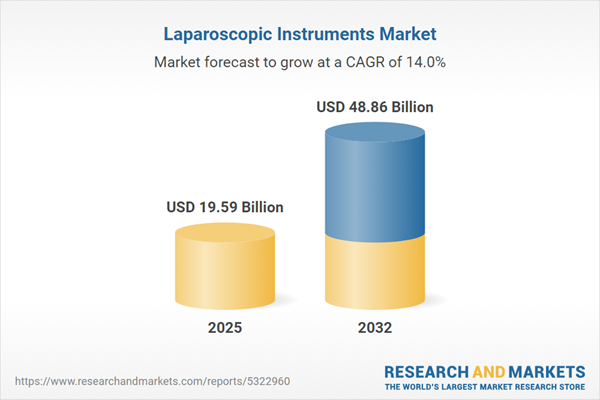Speak directly to the analyst to clarify any post sales queries you may have.
The laparoscopic instruments market is undergoing rapid evolution, with leading healthcare organizations directing focus toward technological innovation and procurement agility. Senior decision-makers are tasked with balancing evolving clinical demands and operational efficiency in an increasingly competitive landscape.
Market Snapshot: Laparoscopic Instruments Market Overview
The global laparoscopic instruments market reached USD 17.18 billion in 2024, posting a robust compound annual growth rate (CAGR) of 13.95%. Growth drivers include rising demand for minimally invasive procedures and a consistent transition toward digital and energy-based surgical platforms. Industry leaders are shifting procurement strategies for cost-effectiveness while ensuring surgical equipment aligns with evolving regulatory standards. With data-driven care models becoming standard practice, organizations are optimizing operating room solutions to maximize value and improve clinical outcomes.
Scope & Segmentation of the Laparoscopic Instruments Market
This report delivers actionable market insights for senior executives who need clarity on sector dynamics, emerging technology, and procurement patterns shaping the laparoscopic instruments market:
- Product Types: Innovations encompass access devices, closure systems, dissectors, energy-based instruments, graspers, hand-held tools, insufflation equipment, laparoscopes, retractors, scissors, suction and irrigation solutions, suturing systems, and trocars. An extensive product mix supports tailored solutions across diverse surgical needs.
- Modes: Choices between disposable and reusable instruments impact cost optimization, environmental sustainability aims, and the ability to adapt equipment use to varying care environments.
- Materials: Essential components such as polymers, stainless steel, and titanium are selected for regulatory compliance, sterility, and compatibility with advanced surgical approaches.
- Applications: Laparoscopic instruments are utilized in pediatric, cardiothoracic, general, gynecological, and urological surgeries, providing flexibility and enabling both specialty-specific and standardized procedures.
- End Users: Hospitals, ambulatory surgery centers, and specialty clinics prioritize procurement strategies that balance high quality standards with strict budget management as the market advances.
- Distribution Channels: Sourcing options range from direct manufacturer relationships to distributor partnerships and customized supplier agreements, emphasizing reliable supply and compliance with industry standards.
- Geographical Coverage: Major regions, including the United States, Germany, China, and India, drive the need for localized strategies, as distinct regulatory requirements and market conditions prompt vendors to adjust product offerings and support services accordingly.
Adoption of digital and robotic-assisted platforms continues to influence integration strategies and workflow optimization. Organizations are prioritizing investment in upgrades that support compliance goals and uniform operative safety protocols.
Key Takeaways for Senior Decision-Makers
- Continuous enhancements in instrument design improve procedural versatility while simplifying the integration of new technologies, supporting ongoing staff development.
- Greater adoption of minimally invasive surgery increases an organization’s flexibility in managing clinical and operational challenges as patient needs evolve.
- Mergers and technology partnerships enable faster access to analytic solutions, supporting evidence-based decision processes and strategic investments.
- Ethically driven sourcing, including prioritization of recyclable materials and responsible procurement practices, is becoming a central factor in supplier negotiations and long-term relationships.
- Standardizing equipment validation and performance review practices supports risk reduction and helps ensure continuation of safe, reliable care delivery.
- Evolving procurement models are structured to address unique regional regulations and reimbursement environments, optimizing resource efficiency across diverse healthcare markets.
Tariff Impact: Navigating Trade and Procurement Challenges
With significant tariff shifts scheduled for 2025, healthcare organizations are reassessing supply chain strategies to minimize disruptions and maintain consistent access to essential surgical equipment. Strategies include expanding supplier networks and increasing regulatory oversight. Manufacturers are adapting operational tactics and evaluating product portfolios to address ongoing trade uncertainties and support market stability.
Methodology & Data Sources
This analysis draws upon senior stakeholder interviews, comprehensive device registry assessments, regulatory and compliance reviews, and in-depth financial evaluations. Real-world operational data is prioritized, providing clinical and executive leaders with a reliable foundation for procurement and technology-driven decisions.
Why This Report Matters
- Aligns deployment of new technologies and procurement frameworks with organizational goals, enhancing both fiscal performance and patient care effectiveness.
- Empowers executive teams to respond with agility to technical developments, regulatory changes, and sourcing challenges to ensure compliance and operational reliability.
- Offers a tested roadmap for optimizing procurement strategies, elevating staff expertise, and maintaining adaptability as healthcare systems undergo transformation.
Conclusion
Modernization, responsible sourcing, and collaborative partnerships support healthcare organizations in maintaining high standards and consistency amid a transforming laparoscopic instruments market.
Additional Product Information:
- Purchase of this report includes 1 year online access with quarterly updates.
- This report can be updated on request. Please contact our Customer Experience team using the Ask a Question widget on our website.
Table of Contents
3. Executive Summary
4. Market Overview
7. Cumulative Impact of Artificial Intelligence 2025
List of Figures
Companies Mentioned
The companies profiled in this Laparoscopic Instruments market report include:- B. Braun SE
- EndoMed Systems GmbH
- Ackermann Instrumente GmbH
- Adronic Endoscope Co., Ltd.
- Applied Medical Resources Corporation
- Becton, Dickinson and Company
- CONMED Corporation
- Cook Group Incorporated
- DEAM Products BV
- Erbe Elektromedizin GmbH
- Intuitive Surgical, Inc.
- Johnson & Johnson Services, Inc.
- KARL STORZ SE & Co. KG
- LIVSMED Inc.
- Mediflex Surgical Products
- Medtronic PLC
- Microline Surgical Inc.
- Olympus Corporation
- Optomic España S.A.
- Peters Surgical
- Richard Wolf GmbH
- RUDOLF Medical GmbH + Co. KG
- Shenzhen Mindray Bio-Medical Electronics Co., Ltd.
- Smith & Nephew PLC
- Stryker Corporation
- Teleflex Incorporated
- Unimax Medical Systems Inc.
- Utah Medical Products, Inc.
- Victor Medical Instruments Co., Ltd.
- Welfare Medical Ltd.
- Zhejiang GeYi Medical Instrument Co. Ltd.
Table Information
| Report Attribute | Details |
|---|---|
| No. of Pages | 199 |
| Published | November 2025 |
| Forecast Period | 2025 - 2032 |
| Estimated Market Value ( USD | $ 19.59 Billion |
| Forecasted Market Value ( USD | $ 48.86 Billion |
| Compound Annual Growth Rate | 13.9% |
| Regions Covered | Global |
| No. of Companies Mentioned | 32 |









